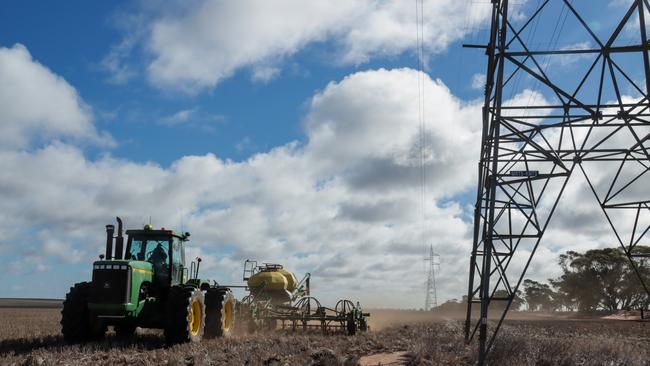AEMO warns more transmission lines needed to support green energy exports
A massive acceleration in building new transmission lines would be needed to support Australia’s emergence as a green hydrogen super power, AEMO warns.

Australia’s ambition of replacing gas exports with green hydrogen could founder because of the sheer scale of transmission lines needed to build a renewable export sector, the power grid operator has warned.
Any hope of turning Australia’s plentiful solar and wind energy into hydrogen exports – or reinvigorating downstream resources processing such as aluminium – rests on the price and stability of the grid.
But AEMO’s latest draft integrated system plan, due for release on Friday, says billions of dollars more will need to be spent on transmission lines to connect renewable energy zones to production hubs near major ports if green energy is to deliver a manufacturing windfall for the Australian economy.
The report pulls forward by five years AEMO’s predictions for the death of coal in the National Electricity Market, compared to the market operator’s 2022 system plan, and says the rollout of both new renewable energy generation, firming options and transmission infrastructure will need to rapidly accelerated to meet the federal government’s 82 per cent renewable energy target by 2030.
About 6 gigawatts of new renewable energy will need to be added to the NEM in the coming decade to replace coal generation, the report says – 50 per cent above the current rollout rate.
And more rapid-reaction gas turbines will be needed, AEMO says, with the draft 2024 ISP lifting its forecast for backup gas-powered generation capacity needed to 16GW by 2050, up from 10GW in the 2022 ISP.
But the report also warns of the risks posed to the NEM by delays in building the new transmission infrastructure needed to link renewable energy zones to the network to replace coal fired generators.
“For the transition to succeed, lights must be kept on and the gas flowing while the new system is put in place. This is a highly complex technical challenge, but also a social and economic one,” the report says.
“Yet rushing the transition is also risky. Market rules need to be in place and well understood, so that timely investments can be made. Global supply chains need to be negotiated so that equipment is available to deliver the transition at reasonable cost. Policies need to ensure that Australia has a skilled workforce to draw on as the transition ramps up. Communities must be engaged so that social licence for these rules and investments is earned.”
The installation of new high voltage lines across farmland in NSW and Victoria is already under fire by farming groups, and the issue is already looming as a hot-button political issue in the regions ahead of the next federal election.
Just delivering on enough transmission infrastructure to keep the grid stable as coal retires is already a big challenge, but the latest AEMO report suggests that building the infrastructure on Australia’s east coast needed to support green energy exports such as hydrogen is likely to be far more difficult.
The 2024 Draft ISP forecasts that close to 10,000km of transmission will be needed by 2050. About 5000 km of this transmission delivery is needed in the next decade, including around 4000 km of new transmission corridors and upgrading about 1000 km of existing lines.
That would need to more than double – and be rolled out at a far more rapid rate – to support green energy exports, the report says.
“In green energy exports (scenario), the NEM would support major new export industries: green energy exported as hydrogen or used to power low-emission heavy industry,” the report says.
“This would require hydrogen electrolysers near existing export ports, served by associated transmission. The less likely green energy exports (scenario) would require 10,000 km of network in the next decade, and a total of 26,000 km through to 2050, with the additional capacity focused on areas useful for export such as ports.”
Under AEMO’s green energy export model, renewable energy generation would need to lift to 550GW by 2050 and around 200GW – expanding quickly enough to see the last coal-fired power station exit the NEM by the early 2030.
The modelling also suggests that proposed green hydrogen hubs at major industrial hubs could struggle to find cheap energy, if the massive generation capacity needed to support hydrogen and cheap manufacturing cannot be connected to the grid quickly enough.
The inability to access cheap green energy was cited as a factor in Fortescue and Incitec delaying a final investment decision on their plans to repurpose Incitec’s Gibson Island manufacturing plant for green ammonia last month.
At the same time Fortescue made a decision to press ahead with a small hydrogen production plant in Gladstone, where Queensland’s Powerlink has recently updated transmission infrastructure.


To join the conversation, please log in. Don't have an account? Register
Join the conversation, you are commenting as Logout